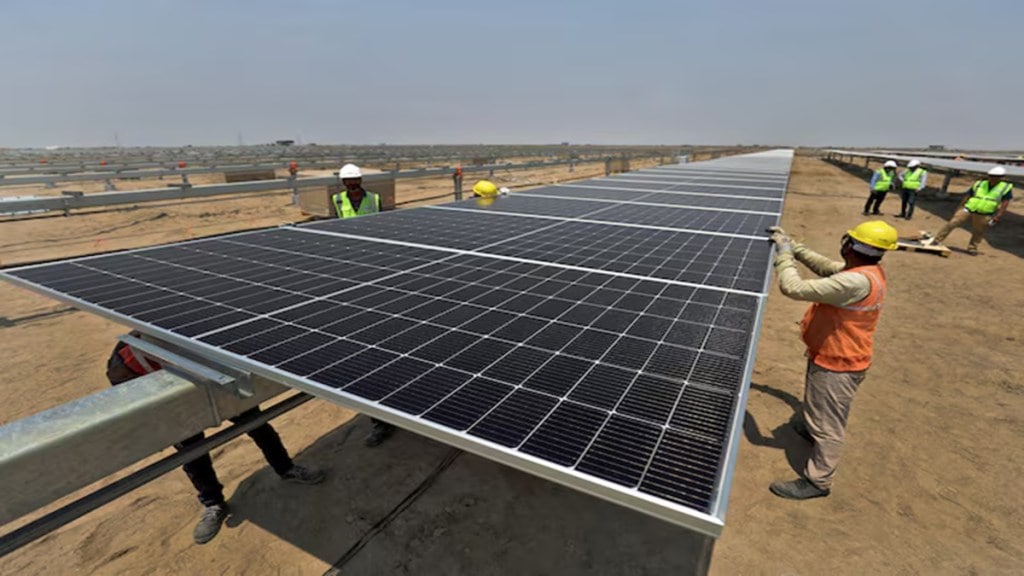The government is actively exploring mechanisms to optimise transmission capacity and improve the contracting framework for renewable energy (RE) projects with stakeholders, to enable efficient addition of RE capacity to the grid, the ministry of new and renewable energy said on Tuesday.
According to the ministry, the feasibility of signing power purchase agreements (PPAs) and power sale agreements (PSAs) for certain awarded capacities will be reviewed. The ministry did not rule out cancellations of some of the awarded projects that are stranded, but indicated that it will only be the last resort.
The move comes in the wake of at least 40 gigawatts (GW) of RE capacity being stranded due to delays in the signing of power sale agreements (PSAs) by the bidding agencies with state distribution utilities (discoms).
The policy shift will also see a “nuanced, case-by-case approach” to the way bidding process is undertaken by agencies like the Solar Energy Corporation of India, with increased focus on grid strength, storage and market reforms, the ministry said in a statement.
The delays in execution of sale agreements are mainly on account of lack of dedicated transmission infrastructure, investments which haven’t kept pace with the RE capacity creation. The pace of utilisation of RE capacity has slowed as a result.
The government may also review the green shoe option, that is, the flexibility to SECI and procurers to raise the total contracted capacity from beyond the originally awarded level.
Experts have been highlighting the issue of RE capacities getting stuck, due to grid connectivity issues, and congestion in many cases after collectivity is achieved. While India’s installed power capacity is almost equally divided between green (including hydro), and thermal power, RE can meet less than a fifth of peak power demand, due to the intermittent nature of this energy, and grid connectivity issues. Though incentives are being offered for RE battery storage systems, and pace of investments, including from the private sector, in the transmission sector has risen, a certain mass of existing RE capacity is awaiting buyers, causing uncertainty among the investor community, and s slowdown in the pace of projects.
The ministry said it is closely monitoring the cases where Letters of Award have been issued by Renewable Energy Implementing Agencies (REIAs), but (PSAs with discoms or end-procurers have not yet been finalised.
As per Icra, the country auctioned a meagre 3.4 GW of green capacity in the first half of the current financial year.
The ministry pointed out that some discoms have expressed apprehensions in signing PSAs for such bids wherein the likely start date of connectivity for the successful bidders is in the distant future.
“REIAs have been advised to carry out due diligence by reviewing and categorizing such cases based on the likelihood of securing PSAs with end procurers. This assessment would consider multiple factors, including the configuration of renewable energy envisaged to be supplied under the bid, the discovered tariff for supply of renewable power and the expected timeline for connectivity,” the ministry said.
It noted that following this review, only those LoAs with minimal or no prospects of PSA execution may be considered for cancellation on a case-to-case basis. Even such cancellations are expected to be “phased” and undertaken only after all feasible and viable options for executing the PSAs and corresponding PPAs have been thoroughly explored.
The government also pointed out that the apprehensions that massive investments in renewable power may get into limbo is “unfounded,” since major investment in any RE project starts only after the execution of PPA. . The investments, if any made by any RE power developer in land or connectivity, are used by the RE power developers for other existing projects or future projects in their portfolio, it added.
As of Sep 30, Renewable Energy Implementing Agencies (REIAs) have issued Letters of Award (LoAs) for 43.9 GW of capacity where PSAs with end procurers remain unsigned, government data showed. Since April 2023, these agencies have successfully signed PSAs for 24.9 GW of capacity.
The country’s installed RE capacity has reached over 197 GW (excluding large hydro) from 35 GW in 2014.
The government now plans to focus not only on adding capacity but also on ensuring that added capacity is absorbed efficiently through grid integration, storage deployment, and market reforms.
To facilitate the execution of PSAs, the government is undertaking several measures including urging states to comply with the Renewable Consumption Obligation (RCO) under the Energy Conservation Act, and advising REIAs to aggregate demand from discoms and other consumers before designing and issuing tenders.
In addition, the Standard Bidding Guidelines for solar, wind, hybrid, and Firm and Dispatchable Renewable Energy (FDRE) have been amended to allow for cancellation of Letters of Award (LoAs) that remain unexecuted beyond 12 months from the date of issuance.
FE had earlier reported that the government plans to remodel plain solar or wind capacities as hybrid, integrating them with a battery energy storage system (BESS) so that it can be used in peak solar hours.
The government has also started sensitizing the REIAs to move from plain solar tenders to tenders of solar plus energy storage tenders with configuration to supply renewable power during peak hours and tenders with configuration to supply firm and dispatchable renewable energy (FDRE).
The government also plans to unlock stranded capacity and enable dynamic corridor sharing with a ₹2.4 lakh crore investment plan for transmission associated with 500 GW of renewable energy, along with recent amendments to the General Network Access regulations. These reforms are expected to ease congestion and improve grid access in renewable-rich states, it said.
India added around 29 GW of renewable energy capacity (excluding large hydro) in the last financial year. Furthermore, around 25 GW has already been added in the first half of FY26. This growth was driven not only by central and state-led bids but also by commercial and industrial consumers.

